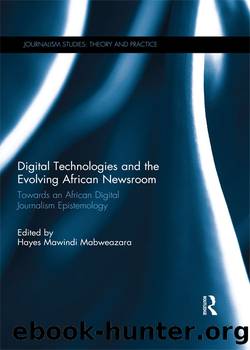Digital Technologies and the Evolving African Newsroom by Hayes Mabweazara

Author:Hayes Mabweazara [Mabweazara, Hayes]
Language: eng
Format: epub
Google: 4lh8zgEACAAJ
Publisher: Routledge
Published: 2016-01-15T05:16:01+00:00
In a significant number of comments, readers tend to challenge our viewpoints or openly express their disagreement with the angles taken in a story, including the sources we use ⦠They also take each other to task and this has far-reaching implications for the reader as it culminates in ânew hybrid textsâ that collectively shape meanings on critical public issues.
This observation chimes with Brunsâ remark that comment forums âoffer a corrective, an alternative interpretation of [issues] by adding the backstory and providing further related (and often contradicting) information enabling readers to better assess for themselves and by themselves the quality and veracity of mainstream news storiesâ (Bruns 2008, 177). Thus, while the news media in Zimbabwe is heavily polarised and partisan, as already noted, the same news online is âopen to a higher degree of contestation than is typical of traditional news mediaâ (Fenton and Witschge 2011, 154).
However, that basic principles of practice remain in place was indicated by the one-sided nature of interactivity on the comment forums. Journalists highlighted that while user comments were useful on several fronts as discussed above, they hardly engaged directly with readers on the platforms. This points to the fact that Zimbabwean newsrooms (as elsewhere in Africa) are still broadly adjusting to the culture of interactivity, including figuring out how best they can actively engage with their readers in the true spirit of participatory and interactive journalism. As AMH's group online editor explained: âwe are still exploring ways of engaging directly with readers without distorting the flow of the discourses on these forums ⦠At the moment we are leaving everything to the readers, let them determine the nature of the interactionsâ. This response relates to Frere's (2014, 250) observations that journalists âare uncertain as to whether they should enter into a new type of relationship with their publicâ in keeping with the cultures and practices emerging with technological changes in their newsrooms. Elsewhere Hermida (2011b, 181) also observes that âthe notion of entering into a substantive exchange of ideas and views with users has not become part of the journalist's ⦠mindsetâ. The relationship âremains rooted in long-established power dynamicsâ (180) which reduce online comments to âlistening devices [which fail to function] as devices for a dialogue between journalists and audiencesâ (181).
Some journalists, however, attributed the lack of direct interactions with readers to the widespread use of pseudonyms and the entering of false email addresses on the comment forums, which made it difficult to generate useful dialogue. This marked a clear distinction with journalistsâ use of other interactive platforms such as social media, especially Facebook, which provided scope for building direct intimate connections with readers and potential sources (see Mabweazara 2014). Consequently, the most direct form of journalistsâ engagement with readersâ comments was in the moderation of the content. This echoes Singer's (2009, 481) observation at The New York Times in which she contends that comment forums were reactive places that did not include journalists beyond simply âmonitoring for abuseâ (I explore this in detail shortly.
Download
This site does not store any files on its server. We only index and link to content provided by other sites. Please contact the content providers to delete copyright contents if any and email us, we'll remove relevant links or contents immediately.
Index to the London Magazine by Frank P. Riga Claude A. Prance(197)
Female Impersonation by Carol-Anne Tyler(140)
Creativity and Feature Writing by Ellie Levenson(128)
A Filtered Life by Nicole Taylor Mimi Nichter(122)
Xenolinguistics; Towards a Science of Extraterrestrial Language by Douglas A. Vakoch & Jeffrey Punske(122)
Theories of Journalism in a Digital Age by Steen Steensen Laura Ahva(118)
Critical Communication Pedagogy by Fassett Deanna L.;Warren John T.; & John T. warren(114)
Torture, Intelligence and Sousveillance in the War on Terror by Vian Bakir(111)
Origin Of Ethnography In Japan by Minoru Kawada(111)
Computing the News: Data Journalism and the Search for Objectivity by Sylvain Parasie(111)
Developing Translanguaging Repertoires in Critical Teacher Education by Zhongfeng Tian Nicole King(111)
Peace Journalism in East Africa by Fredrick Ogenga(105)
Transformative Media Pedagogies by Paul Mihailidis Sangita Shresthova Megan Fromm(104)
Matter Transmission by Nicolás Salazar Sutil(98)
Revisiting Transnational Broadcasting by Nelson Ribeiro Stephanie Seul(96)
A Networked Self and Platforms, Stories, Connections by Zizi Papacharissi(95)
Media Studies 2.0 by William Merrin(94)
Media Audiences by Sue Turnbull(94)
The Gentrification of the Internet by Jessa Lingel(94)
